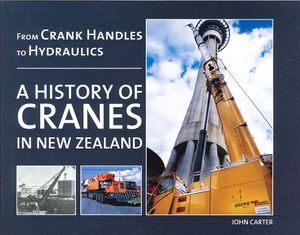From Crank Handles to Hydraulics
From Crank Handles to Hydraulics A History of Cranes in New Zealand
John Carter ISBN 9781877572661Crane Association of New Zealand, 2011
The Blurb:
Cranes of various shapes and sizes have helped shape our nation dating back to around 1840 and today rank as the most familiar item of equipment involved on construction and other sites throughout New Zealand. This book is the first ever produced in New Zealand detailing how cranes and other lifting devices have evolved over the decades. People from all walks of live continually marvel at the size of the units, their general make-up, the tasks they are capable of performing and the skill of those people working with the cranes. For this reason technical detail has been kept to a minimum giving the publication universal appeal to even those with only the remotest or even no real interest in cranes. This 300 page hardcover high quality book is a balanced mix of text, photos and illustrations. It is an easy read for people of all ages and includes how cranes assisted in the colonisation of New Zealand via the ports and railways and mention of some of the country’s historical events which necessitated the use of cranes."
Mini Review
This is a POP page.
|
Why do cranes have few lovers? Old boats, planes, trains, cars, even stationary engines have legions and many examples are preserved, often in loving working order. Cranes not – of the many that have worked in New Zealand few are preserved. A few decrepit examples exist in situ. Railway cranes and two floating cranes seem to be the exceptions. Perhaps too many were in inconvenient places and or they were too massive to consider moving or the maintenance. Anyway the cutting torch has taken most. Carter’s book is some compensation for he has mined the records and literature for pictures and accounts. It is not a technical book. There is relatively little on the mechanics of the cranes and non-engineers are spared too many engineering drawings. However the context within which they worked is very apparent and the contribution they have made to our infrastructure and major projects is clear.
A surprise with wharf cranes was the early popularity of hydraulic cranes. Not apparent here but a little research shows the working fluid was water, far different from the mobile hydraulic (oil ) cranes now so common in construction. The latter part of the book gives some Association related material and a fair bit is about crane owners so that is more for industry insiders.
The enthusiasm of crane builders for suggestive names is to be enjoyed: Goliath, Jumbo, Hercules, Samson and Titan. All up, a worth addition to industrial history and a good source for industrial archaeologists.
